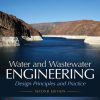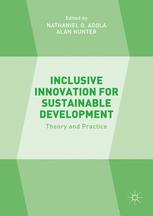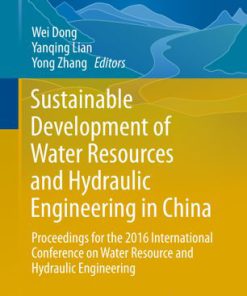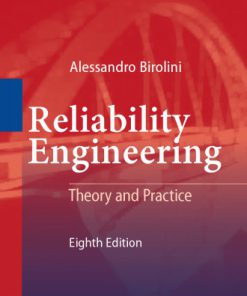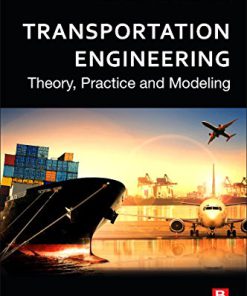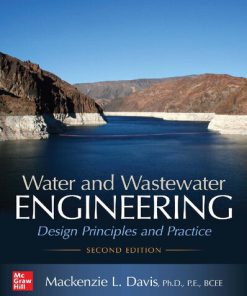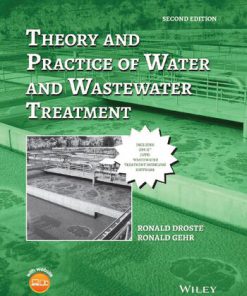Sustainable Water Engineering Theory and Practice 1st Edition by Ramesha Chandrappa 9781118541043 1118541049
$50.00 Original price was: $50.00.$25.00Current price is: $25.00.
Sustainable Water Engineering Theory and Practice 1st Edition by Ramesha Chandrappa – Ebook PDF Instant Download/Delivery:9781118541043,1118541049
Full download Sustainable Water Engineering Theory and Practice 1st Edition after payment

Product details:
ISBN 10:1118541049
ISBN 13:9781118541043
Author:Ramesha Chandrappa
Ensuring safe and plentiful supplies of potable water (both now and for future generations) and developing sustainable treatment processes for wastewater are among the world’s greatest engineering challenges. However, sustainability requires investment of money, time and knowledge. Some parts of the world are already working towards this goal but many nations have neither the political will nor the resources to tackle even basic provision and sanitation. Combining theory and practice from the developing and developed worlds with high- and low-tech, high- and low-cost solutions, this book discusses fundamental and advanced aspects of water engineering and includes:
- water resource issues including climate change, water scarcity, economic and financial aspects
- requirements for sustainable water systems
- fundamentals of treatment and process design
- industrial water use and wastewater treatment
- sustainable effluent disposal
- sustainable construction principles
With integrated theory, design and operation specifications for each treatment process, this book addresses the extent to which various treatment methods work in theory as well as how cost effective they are in practice. It provides a nontechnical guide on how to recover and reuse water from effluent, which is suitable for those in water resource management, environmental planning, civil and chemical engineering.
Sustainable Water Engineering Theory and Practice 1st Table of contents:
1 Water Crisis
1.1 Water Resource Issues
1.1.1 Water Footprint
1.2 Climate Change and Its Influence on Global Water Resources
1.3 Protection and Enhancement of Natural Watershed and Aquifer Environments
1.4 Water Engineering for Sustainable Coastal and Offshore Environments
1.5 Endangering World Peace and Security
1.6 Awareness among Decision Makers and the Public across the World
1.7 Criteria for Sustainable Water Management
1.8 Water Scarcity and Millennium Development Goals
1.9 Lack of Access to Clean Drinking Water and Sanitation
1.10 Fragmentation of Water Management
1.11 Economics and Financial Aspects
1.11.1 Water Treatment and Distribution
1.11.2 Wastewater Treatment, Collection and Disposal
1.12 Legal Aspects
References
2 Requirements for the Sustainability of Water Systems
2.1 History of Water Distribution and Wastewater Collection
2.2 Integrated Water Management
2.3 Sewerage Treatment and Urban Pollutin Management
2.4 Conventional Water Supply
2.4.1 Features
2.4.2 Capacity and Pressure Requirements
2.4.3 Design and Hydraulic Analysis of Distribution System
2.4.4 Unsustainable Characteristics
2.4.5 Sustainable Approach
2.5 Conventional Wastewater Collection Systems
2.5.1 Features
2.5.2 Unsustainable Characteristics
2.5.3 Sustainable Approach
References
3 Water Quality Issues
3.1 Water-Related Diseases
3.1.1 Transmission Vectors
3.1.2 Field Testing and Monitoring
3.1.3 Village-Level Monitoring
3.2 Selection Options for Water Supply Source
3.2.1 Spring Capping
3.2.2 Simple Tube Wells
3.2.3 Hand Pumps
3.2.4 Rainwater Harvesting
3.2.5 Fog and Dew Harvesting
3.2.6 Snow Harvesting
3.3 On-Site Sanitation
3.3.1 Latrines
3.3.2 Septic Tanks
3.3.3 Aqua Privies
3.3.4 Oxidation Pond Treatment Systems
3.3.5 Storm Drainage
3.4 Water Quality Characteristics of Potable Drinking Water and Wastewater Effluents
3.4.1 Physical Parameters
3.4.2 Chemical Parameters
3.4.3 Solids in Water
3.4.4 Biological Parameters
3.5 Standards and Consents
3.5.1 Potable Water Standards
3.5.2 Wastewater Effluent Standards
3.6 Kinetics of Biochemical Oxygen Demand
3.7 Water Management for Wildlife Conservation
3.8 Water-Quality Deterioration
References
4 Fundamentals of Treatment and Process Design, and Sustainability
4.1 History of Water and Wastewater Treatment Regulatory Issues across the World
4.1.1 Low-Tech versus Hi-Tech
4.1.2 Low Cost versus High Cost
4.2 Design Principles for Sustainable Treatment Systems
4.2.1 Low Carbon
4.2.2 Low Energy
4.2.3 Low Chemical Use
4.2.4 Modelling of Treatment Processes to Attain Sustainability
4.2.5 Operation, Management, Financial, Socio-Economic Aspect
4.3 Preliminary and Primary Treatment
4.3.1 Screening
4.3.2 Coarse-Solid Reduction
4.3.3 Grease Removal Chamber
4.3.4 Flow Equalization
4.3.5 Mixing and Flocculation
4.3.6 Sedimentation
4.3.7 Flotation
4.4 Secondary Treatment
4.4.1 Biological Treatment
4.4.2 Vermifiltration
4.4.3 Chemical Treatment
4.5 Tertiary Treatment
4.5.1 Filtration
4.5.2 Activated Carbon Treatment
4.5.3 Ion Exchange
4.5.4 Forward and Reverse Osmosis, Membrane Filtration, Membrane Bioreactor, Membrane Distillation, and Electro Dialysis
4.5.5 Air Stripping
4.5.6 Disinfection and Fluoridation
4.5.7 Removal of Specific Constituents
4.6 Emerging Technologies
4.6.1 Nanotechnology applied for Water Purification
4.6.2 Photocatalysis
4.6.3 Evaporation
4.6.4 Incineration
4.6.5 Sono-Photo-Fenton Process
4.7 Residual Management
4.7.1 Thickening
4.7.2 Drying
4.7.3 Stabilization
4.7.4 Digestion
4.7.5 Composting
4.7.6 Dewatering
4.7.7 Incineration
4.7.8 Remediation of Contaminants in Subsurface
4.8 Portable Water Purification Kit
4.9 Requirements of Electrical, Instrumentation and Mechanical Equipment in Water and Wastewater Treatment to Achieve Sustainability
4.9.1 Electrical Equipment and Energy Requirement
4.9.2 Piping and Instrumentation
4.9.3 Mechanical Equipment Requirements and Related Issues
4.9.4 Systems and Operational Issues
4.9.5 Real-Time Control
4.9.6 Indicators of Sustainable Performance; Systems Approach for Sustainability Assessment of Water Infrastructure
4.9.7 Troubleshooting
4.9.8 Operational Checks for the STP
4.9.10 Odour Management
References
5 Sustainable Industrial Water Use and Wastewater Treatment
5.1 Sustainable Principles in Industrial Water Use and Wastewater Treatment
5.1.1 Industries with High Dissolved Solids
5.1.2 Industries/Activities with High Inorganic Content
6 Sustainable Effluent Disposal
6.1 Dissolved Oxygen Sag Curves, Mass Balance Calculations and Basic River Models
6.2 Disposal Options and Impact on Environment
6.2.1 Ocean Disposal
6.2.2 Disposal into Fresh Water Bodies
6.2.3 On-Land Disposal
6.3 Sustainable Reuse Options and Practice
6.3.1 Toilet Flushing
6.3.2 Floor Washing
6.3.3 Sustainable Wastewater Irrigation
6.3.4 Nonpotable Industrial Use
References
7 Sustainable Construction of Water Structures
7.1 Sustainable Construction – Principles
7.1.1 Green Building
7.1.2 Cementless Construction
7.1.3 Choosing Eco-Friendly Construction Material
7.1.4 Energy Saving during Construction
7.1.5 Precautions to be Taken during Construction to save Energy during Operations
7.2 Intake Structures
7.3 Treatment Plants
7.4 Water Storage and Distribution Systems 344
7.5 Wastewater Collection and Disposal System
References
8 Safety Issues in Sustainable Water Management
8.1 Health, Safety and Sustainability
8.2 Safety of Consumer versus Operator
8.3 Safety of People and Animals other than Consumers and Operators
8.4 Safety Issues during Construction
8.4.1 Electrical Protective Devices
8.5 Chemical Handling and Storage
8.5.1 Chlorine
8.5.2 Herbicides/Pesticides
8.6 Safety during Water/Wastewater Treatment Plant Operation
8.6.1 Work-Permit System
8.7 Disaster Management
People also search for Sustainable Water Engineering Theory and Practice 1st:
the theory and practice of sustainable engineering pdf
water and wastewater engineering design principles and practice pdf
water and wastewater engineering design principles and practice
sustainable water technology
study water engineering
Tags:
Ramesha Chandrappa,Engineering,Practice,Sustainable
You may also like…
Business & Economics
Inclusive Innovation for Sustainable Development: Theory and Practice 1st Edition Nathaniel O. Agola
Engineering
Through life Engineering Services Motivation Theory and Practice 1st Edition Louis Redding
Engineering - Civil & Structural Engineering
Transportation Engineering Theory Practice and Modeling 1st Edition Dusan Teodorovic
Engineering - Environmental
Engineering
Engineering Optimization Theory and Practice 5th Edition by Singiresu Rao 1119454793 9781119454793
Technique - Water Treatment
Engineering
Theory and practice of water and wastewater treatment Second Edition. Edition Ronald L. Droste


